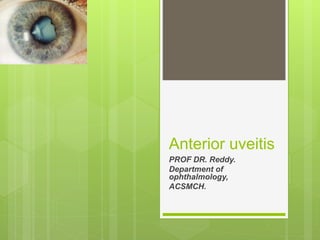The document provides a comprehensive overview of anterior uveitis, detailing its definitions, classifications (anatomical, clinical, etiological, and pathological), and associated clinical signs and symptoms. It emphasizes the various causes, including autoimmune disorders and infections, as well as the typical treatment approaches, such as corticosteroids and mydriatics. Additionally, it outlines potential complications, diagnostic investigations, and differentiates anterior uveitis from other ocular conditions.
































































